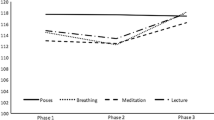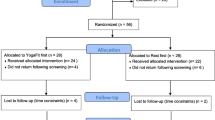Abstract
The present study was conducted to evaluate a statement in ancient yoga texts that suggests that a combination of both “calming” and “stimulating” measures may be especially helpful in reaching a state of mental equilibrium. Two yoga practices, one combining “calming and stimulating” measures (cyclic meditation) and the other, a “calming” technique (shavasan), were compared. The oxygen consumption, breath rate, and breath volume of 40 male volunteers (group mean ± SD, 27.0 ± 5.7 years) were assessed before and after sessions of cyclic meditation (CM) and before and after sessions of shavasan (SH). The 2 sessions (CM, SH) were 1 day apart. Cyclic meditation includes the practice of yoga postures interspersed with periods of supine relaxation. During SH the subject lies in a supine position throughout the practice. There was a significant decrease in the amount of oxygen consumed and in breath rate and an increase in breath volume after both types of sessions (2-factor ANOVA, paired t test). However, the magnitude of change on all 3 measures was greater after CM: (1) Oxygen consumption decreased 32.1% after CM compared with 10.1% after SH; (2) breath rate decreased 18.0% after CM and 15.2% after SH; and (3) breath volume increased 28.8% after CM and 15.9% after SH. These results support the idea that a combination of yoga postures interspersed with relaxation reduces arousal more than relaxation alone does.
Similar content being viewed by others
REFERENCES
Brown, D. R., Wang, Y., Ward, A., Ebbeling, C. B., Fortlage, L., Puleo, E., Benson, H., & Rippe, J. M. (1995). Chronic psychological effects of exercise and exercise plus cognitive strategies. Medicine and Science in Sports and Exercise, 27(5), 765–775.
Chinmayananda, S. (1984). Mandukya upanisad. Bombay: Sachin Publishers.
Das, T. K., & Jana, H. (1991). Basal oxygen consumption during different phases of menstrual cycle. Indian Journal of Medical Research, 94, 16–19.
Falk, B. (1995). Effect of continuous and intermittent exercise on energy expenditure and on the cardiorespiratory response. Perceptual and Motor Skills, 80(1), 64–66.
International Union of Physiological Sciences Commission (1991). Report of the IUPSC on teaching physiology. Singapore: World Scientific.
Jin, P. (1992). Efficacy of Tai Chi, brisk walking, meditation, and reading in reducing mental and emotional stress. Journal of Psychosomatic Research, 36(4), 361–370.
Lorig, T. S., & Schwartz, G. E. (1990). The pulmonary system. In J. T. Cacioppo & L. G. Tassinary (Eds.), Principles of Psychophysiology. Cambridge: Cambridge University Press.
Maharishi Mahesh Yogi (1972). The science of creative intelligence. New York: Age of Enlightenment Press.
Matsuo, T., Saitoh, S., & Suzuki, M. (1999). Effects of the menstrual cycle on excess postexercise oxygen consumption in healthy young women. Metabolism, 48(3), 275–277.
Miles, W. R. (1964). Oxygen consumption during three yoga-type breathing patterns. Journal of Applied Physiology, 19, 75–82.
Mountcastle, V. B. (1980). Medical physiology (Vol. 2). St. Louis: CV Mosby.
Nagendra, H. R., & Nagarathna, R. (1997). New perspectives in stress management. Bangalore: Vivekananda Kendra Prakashan.
Rai, L., & Ram, K. (1993). Energy expenditure and ventilatory responses during virasana—a yogic standing posture. Indian Journal of Physiology and Pharmacology, 37(1), 45–50.
Rai, L., Ram, K., Kant, U., Madan, S. K., & Sharma, S. K. (1994). Energy expenditure and ventilatory responses during siddhasana—a yogic seated posture. Indian Journal of Physiology and Pharmacology, 38(1), 29–33.
Rao, S. (1968). Oxygen consumption during yoga-type breathing at altitudes of 520 m and 3800 m. Indian Journal of Medical Research, 56, 701–705.
Shephard, R. J. (1997). Exercise and relaxation in health promotion. Sports Medicine, 23(4), 211–217.
Taimini, I. K. (1961). The science of yoga. Madras: The Theosophical Publishing House.
Telles, S., Nagarathna, R., & Nagendra, H. R. (1994). Breathing through a particular nostril can alter metabolism and autonomic activities. Indian Journal of Physiology and Pharmacology, 38, 133–137.
Telles, S., Nagarathna, R., & Nagendra, H. R. (1995). Autonomic changes during 'OM' meditation. Indian Journal of Physiology and Pharmacology, 39(4), 418–420.
Telles, S., Nagarathna, R., & Nagendra, H. R. (1996). Physiologic measures of right nostril breathing. Journal of Alternative and Complementary Medicine, 2(4), 479–484.
Wallace, R. K., & Benson, H. (1972). The physiology of meditation. In Altered states of awareness: Readings from scientific american. San Francisco: W.H. Freeman and Company.
Wallace, R. K., Benson, H., & Wilson, A. F. (1971). A wakeful hypometabolic physiologic state. American Journal of Physiology, 221, 795–799.
Author information
Authors and Affiliations
Rights and permissions
About this article
Cite this article
Telles, S., Reddy, S.K. & Nagendra, H.R. Oxygen Consumption and Respiration Following Two Yoga Relaxation Techniques. Appl Psychophysiol Biofeedback 25, 221–227 (2000). https://doi.org/10.1023/A:1026454804927
Issue Date:
DOI: https://doi.org/10.1023/A:1026454804927




